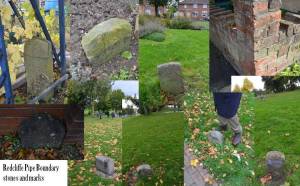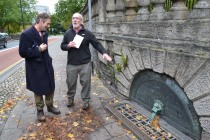The Redcliffe Pipe and its walk – a 923 year old tradition
When is a well a holy well? Ruge well in Bristol, may not having any history of healing, association with saints or legends but by its association with the grand church of St. Mary Redcliffe and the continuation a unique tradition makes it a worthy consideration for this blog. The well is one of the few surviving and largely functioning springs which fall between two forms of classification, neither holy (or healing) nor domestic, by its association with the church it could be considered holy and as such I have included such sites in my surveys, but clearly there does not appear to have been anything sacred thought about it. But what is more remarkable is that there remains a surviving custom associated with it which dates back on and off 900 years! 

An ongoing gift
The giving of the spring head by a member of the Berkeley family of nearby Berkeley Castle dating back to 1190 is perhaps the only such one surviving. The record reads:
“The Grant by Robert de Berkeley, at the instance of William, Chaplain of the church of St. Mary Redcliffe, to the said Church of the well called Rugewell, which is between his wood and that of Robert de Werve, with free access thereto. With a proviso that the hospital that the hospital of St. John the Baptist, Redcliffe, shall have a pipe as ‘mensuram unius mediocris pollicis’ for carrying water to their building.”
So reads the grant recorded in the Bristol record office dated 1190. What is surprising that not only does this spring still flow towards the church, an annual inspection of the source and pipe continues to this day. This was made possible by Juliana, Robert’s wife who affirmed that ‘the Church and her Ministers were allowed to lead off the stream of the well over the demense lands and lands of the tenants, through fence and enclosure and meadow and pasture by a conduit to the church in perpetuitary However, the first record of the pipe is not until 1552 the pipe gets its first notice when the vestry accounts recorded there is a charge for the purchase for the use of pipe for a house, the rental of which continues for a number of years. When the annual inspection begun is unrecorded but it is assumed to be when the grant was given.
Annual inspection.
This annual event was not at one point unique in the city, a similar annual inspection was undertaken by the city corporation of the Raven’s Well, also in Knowle and its conduit, called the Temple Conduit. This inspection being paid by an annual Temple fair, whose rowdy reputation, led to its closure and as a result without its annual meal. 
 The Pipe walk similarly was associated with annual meal, although when abandoned is unclear, whatever it did not stop the custom although it is possible that it may have been responsible for its temporary abandonment and revival in 1928 as reported by the Bristol Evening Post. An amusing account from Pipes, pumps and conduits reads:
The Pipe walk similarly was associated with annual meal, although when abandoned is unclear, whatever it did not stop the custom although it is possible that it may have been responsible for its temporary abandonment and revival in 1928 as reported by the Bristol Evening Post. An amusing account from Pipes, pumps and conduits reads:
“Had you passed by the Wells Road on Thursday week, you would have seen a small troup of substantial citizens, walking with their sticks in hand, resolutely bent on a rustic expedition; and had you followed them, they would have led you through the fields about a mile further on, to a farm at Lower Knowle. Here the jolly pilgrims would have come to a standstill at a flat stone, about two feet square, in the centre of some ploughed ground. Presently a couple of plumbers, who accompanied them, raise the stone and disclose down below a deep subterraneous and good sized chamber, which it would require the light of Aladdin’s lamp to explore. There is a good deal of joking amongst the gentlemen as to who shall descend the ladder first, and as you look around and see amongst them several plump worthies, you come to the conclusion that to them ‘the descendent to Avernus’ is not only ‘not easy’ but physically impossible; but there are among them slim gentlemen, whom parish dinners, have not blown out, and these come forward and disappear one by one into the bowels of the earth, leaving their ‘fat friends’ behind, not only loath but unable to quit the warm precincts of the cheerful day.”
The description of the well head indicates that post that date some considerable improvements were made and now the well, enclosed with allotments, is a substantial stone well house. When the door is opened, now a rather ugly metal one, an older chamber is visible in which a considerable flow was visible. However, one is mistaken if thinking that this structure is the true well for a few feet behind it some land hand given way and a deep stone lined conduit could be seen. Beyond this is a circular boggy area where the springs arise. The report states:
“Don’t be afraid to descend the ladder after those who have been hardy enough to get down, and there by the flicker of a lamp and the occasional flash of a lighter cigar, you will see sparkling up from the fissure of the living rock the water of Ruge Well.”
The route
From this spring a pipe line was laid travelling two miles to a tap conduit head near the church. This route has changed little since the 1190s although urbanisation has sprung up to enclose it and now Victorian pipe has replaced whatever medieval structure there was; the route remains fossilised in time. From the spring head the walk takes itself through allotments, much to the bemusement of those tilling it, down narrow lanes, along streets, at certain points, small stone monuments mark the pipe. If you were not looking for them you would miss them! Most vaguely reading SMP. At certain points, most amusingly in the garden of a ‘modern’ house a manhole cover is lifted and the pipe revealed. What is particularly interesting is how the depth of this pipe becomes increasingly greater to where we reach Victoria Park, where a ladder is needed to descend some distance into the earth. At this last one, ceremonies appear to have developed; in early times the walkers would take a refreshing draft from the pipe…not recommended now but probably welcomed then. The other being the bumping of new attendees on the walk, a ritual often associated with boundary walks which was done to ensure the walkers remembered the marks. The above account also suggests other aspects of beating of the bounds were done – the hitting of the markers with ‘their sticks in hand.’ In 1990, when the 900 years of the pipe was celebrated a token walk over the railway line was done here. This is because despite the presence of an underpass and the importance of this main line, walkers arranged for the trains to be stopped so all the walkers could cross. During the 900th walk, a celebration peal of the church was also rang during it and the Bedminster Citadel Band of the Salvation Army played at one of the stopping points.
A water labyrinth
Also in Victoria Park is a delightful and unique fountain head, the result in 1984 of Wessex water needing to build a sewer across Victoria Park where the pipe ran. The resulting labyrinth was created based on one depicted on a boss of St. Mary Redcliffe. The pipe water fills this labyrinth, the water flowing around the pattern. From the Park, under the railway and down Spring Lane, the pipe travelled over Bedminster bridge and up to the church to fill a tank in the church yard and flow from a lion headed pipe over which reads translated from Latin:
“For the health of the soul of Robert Berkeley, who gave to God and the church of St. Mary Redcliffe and its ministers the Rugewell and conduit. AD 1190 Erected.”
Sadly, during the Second World War, the pipe got a direct hit, however in the 1990s, the source of its break was located and now the flow continues, albeit rather rusty looking to the tank behind the fountain head. It has yet to flow from the lion’s mouth. So Bristol’s Pipe and its walk is a curious survival. It survived the Reformation unlike many church related customs, probably became it was not necessarily associated with ritual but function. It survived the 1800s, when similar customs such as the Temple Walk declined. It survived the wars, although I believe it ceased for the First World War. And it continues to survive long after there is any need for its waters. Yet it is a worthy celebration of the importance of water and long may it continue.
Posted on November 18, 2013, in Bristol, Survival tradition and tagged Bristol, calendar customs, Conduit, folklore, labyrinth, most Mary redcliffe, Redcliffe pipe walk, St. Mary Redcliffe, Victoria park. Bookmark the permalink. 2 Comments.





I follow the activities of the Redcliffe Pipe Walk with great interest.
I reckon that the last time a baby was baptised in St Mary Redcliffe Church using Rugewell water was in 1535.
Why not campaign for St Mary Redcliffe to offer an option for baptism using Rugewell water? It would be of great local interest to see it happen.
Ray Milton
That’s a good idea Ray perhaps the walkers could carry the water!?